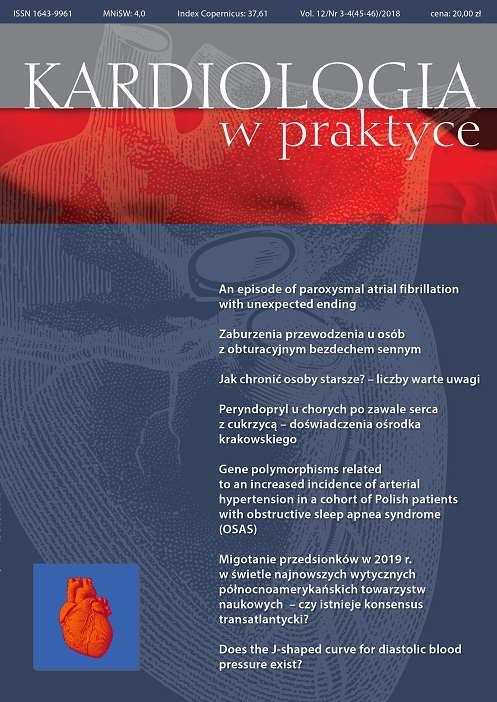Związek polimorfizmu wybranych genów ze zwiększoną częstością nadciśnienia tętniczego – badanie w populacji polskich pacjentów z obturacyjnym bezdechem podczas snu (OSAS) Artykuł oryginalny
##plugins.themes.bootstrap3.article.main##
Abstrakt
Wprowadzenie: Obturacyjny bezdech podczas snu (OSA) jest niezależnym czynnikiem ryzyka nadciśnienia tętniczego (NT). Ze względu na to, że OSA i NT często ze sobą współwystępują, można podejrzewać, że mają one wspólne podłoże genetyczne.
Materiał i metody: W badaniu wzięło udział 600 uczestników z rozpoznanym OSA, we wszystkich stopniach nasilenia choroby. Badanie przeprowadzono w 2 ośrodkach III stopnia referencyjności w Warszawie. U wszystkich pacjentów przeprowadzono badanie polisomnograficzne oraz diagnostykę w kierunku NT. Analizowano polimorfizm genów kodujących ALOX5AP, SREBF2, ADRA2A, APOA5 i TCF7L2 w próbkach krwi. W analizie wykorzystano test Chi2 oraz Manna-Whitneya.
Wyniki: Dane 449 (74,8%) mężczyzn oraz 151 (25,2%) kobiet zostały poddane analizie. NT rozpoznano u 427 (71,2%) uczestników. W grupie chorych z NT i OSA mediana wieku wynosiła 59 (53–64) lat, BMI 32,8 (28,9–37,3) kg/m2, AHI 39 (24–60)/h. Spośród analizowanych polimorfizmów tylko TCF7L2 ([C/T] rs7903146) okazał się związany ze zwiększonym ryzykiem NT.
Wnioski: Wyniki naszej analizy wskazują na potencjalny związek pomiędzy polimorfizmem TCF7L2 ([C/T] rs7903146) i NT, konieczne są jednak dalsze badania uwzględniające wpływ genetycznych oraz tradycyjnych czynników ryzyka.
Pobrania
##plugins.themes.bootstrap3.article.details##

Utwór dostępny jest na licencji Creative Commons Uznanie autorstwa – Użycie niekomercyjne 4.0 Międzynarodowe.
Copyright: © Medical Education sp. z o.o. This is an Open Access article distributed under the terms of the Attribution-NonCommercial 4.0 International (CC BY-NC 4.0). License (https://creativecommons.org/licenses/by-nc/4.0/), allowing third parties to copy and redistribute the material in any medium or format and to remix, transform, and build upon the material, provided the original work is properly cited and states its license.
Address reprint requests to: Medical Education, Marcin Kuźma (marcin.kuzma@mededu.pl)
Bibliografia
2. Phillips B. Sleep-disordered breathing and cardiovascular disease. Sleep Med Rev 2005; 9: 131-140.
3. Robinson GV, Stradling JR, Davies RJ. Sleep. 6: obstructive sleep apnoea/hypopnoea syndrome and hypertension. Thorax 2004; 59: 1089-1094.
4. Pepperell JC, Ramdassingh-Dow S, Crosthwaite N et al. Ambulatory blood pressure after therapeutic and subtherapeutic nasal continuous positive airway pressure for obstructive sleep apnoea: a randomised parallel trial. Lancet 2002; 359 (9302): 204-210.
5. Riha RL, Brander P, Vennelle M et al. Tumor necrosis factor-alpha (-308) gene polymorphism in obstructive sleep apnoea-hypopnoea syndrome. Eur Respir J 2005; 26: 673-678.
6. Bhushan B, Guleria R, Misra A et al. TNF-alpha gene polymorphism and TNF-alpha levels in obese Asian Indians with obstructive sleep apnea. Respir Med 2009; 103: 386-392.
7. Bayazit YA, Yilmaz M, Erdal E et al. Role of nitric oxide synthase gene intron 4 and exon 7 polymorphisms in obstructive sleep apnea syndrome. Eur Arch Otorhinolaryngol 2009; 266: 449-454.
8. Lavie L, Lotan R, Hochberg I et al. Haptoglobin polymorphism is a risk factor for cardiovascular disease in patients with obstructive sleep apnea syndrome. Sleep 2003; 26: 592-595.
9. Liu HG, Liu K, Zhou YN et al. Relationship between reduced nicotinamide adenine dinucleotide phosphate oxidase subunit p22phox gene polymorphism and obstructive sleep apnea-hypopnea syndrome in the Chinese Han population. Chin Med J 2009; 122: 1369-1374.
10. Lõhmussaar E, Gschwendtner A, Mueller JC et al. ALOX5AP gene and the PDE4D gene in a central European population of stroke patients. Stroke 2005; 36: 731-736.
11. Fan YM, Karhunen PJ, Levula M et al. Expression of sterol regulatory element-binding transcription factor (SREBF)2 and SREBF cleavage-activating protein (SCAP) in human atheroma and the association of their allelic variants with sudden cardiac death. Thromb J 2008; 6: 17. http:/doi.org/10.1186/1477-9560-6-17.
12. Lima JJ, Feng H, Duckworth L et al. Association analyses of adrenergic receptor polymorphisms with obesity and metabolic alterations. Metabolism 2007; 56(6): 757-765.
13. Laurila PP, Naukkarinen J, Kristiansson K et al. Genetic association and interaction analysis of USF1 and APOA5 on lipid levels and atherosclerosis. Arterioscler Thromb Vasc Biol 2010; 30: 346-352.
14. Lyssenko V, Lupi R, Marchetti P et al. Mechanisms by which common variants in the TCF7L2 gene increase risk of type 2 diabetes. J Clin Invest 2007; 117(8): 2155-2163.
15. Iber C, Ancoli-Israel S, Chesson AL, Jr, Quan SF. The AASM Manual for the Scoring of Sleep and Associated Events: Rules, Terminology and Technical Specifications. American Academy of Sleep Medicine 2007.
16. Haas DC, Foster GL, Nieto FJ et al. Age-dependent associations between sleep – disordered breathing and hypertension. Circulation 2005; 111: 614-621.
17. Planes C, Leroy M, Fayet G et al. Exacerbation of sleep-apnea related nocturnal blood pressure fluctuations in hypertensive subjects. Eur Respir J 2002; 20: 151-157.
18. Rahmouni K, Correia ML, Haynes WG et al. Obesity-associated hypertension: new insights into mechanisms. Hypertension 2004; 45: 9-14.
19. Grant SF. Understanding the elusive mechanism of action of TCF7L2 in metabolism. Diabetes 2012; 61(11): 2657-2658.
